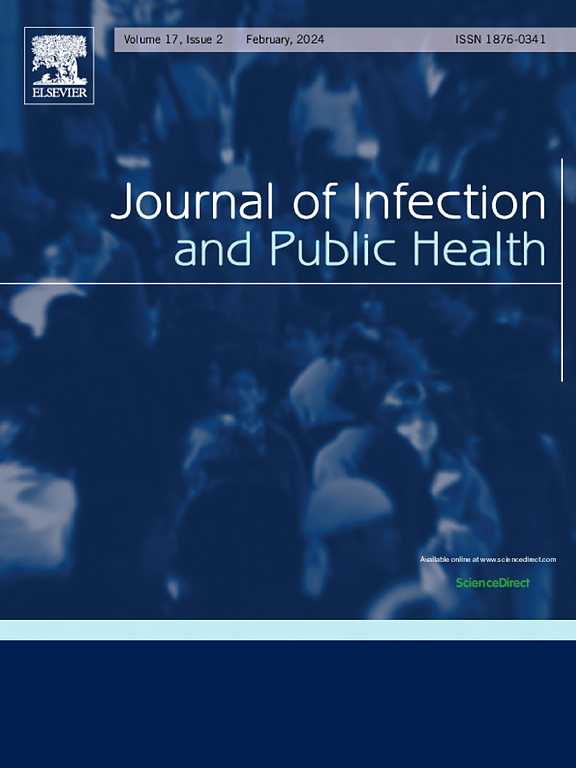Pertussis clinical profile shift, severity, prediction in a tertiary hospital: A comparative study before, during, and after COVID-19 in Southern China
IF 4.7
3区 医学
Q1 INFECTIOUS DISEASES
引用次数: 0
Abstract
Objective
To analyze the epidemiological characteristics, clinical manifestations, antimicrobial resistance and develop a predictive model for severe pertussis spanning five years – before, during, and after the COVID-19 pandemic – in Shenzhen children’s hospital in southern China, aiming to provide insights into the pandemic impact and control measures on the pertussis disease profile.
Methods
Demographic, clinical, vaccination, and laboratory data were collected for patients who tested positive for pertussis by polymerase chain reaction and/or culture from January 1, 2019, to March 30, 2024. Analysis included changes in demographic and clinical features, indicators of severe cases, and resistance patterns over the study period.
Results
During this period, 3963 patients were diagnosed, with 79 severe (PICU admitted) cases; 1433 isolates underwent antimicrobial susceptibility testing. In late 2023, pertussis cases began to increase. From 2019 to 2024, the proportion of cases among 4–6 year olds rose from 4.9 % to 28.6 %, and among 7–11 year olds from 0.7 % to 21.2 %. Macrolide resistance surged from 46.5 % in 2019 to 97.3 % in 2024, with 80 % of resistant hospitalized cases initially treated with macrolides. Clinical severity and co-infection increased post-pandemic, with a larger number of cases necessitating antibiotic changes and enhanced supportive care. Vaccination protected against severe disease. Indicators such as white blood cell count, lymphocyte to neutrophil ratio, platelet count, cyanosis and pneumonia predicted disease severity.
Conclusions
Post-pandemic, pertussis cases shifted from infants to school-aged children, with increased clinical severity and high macrolide resistance. Urgent measures are needed to optimize vaccination schedules and develop management strategies addressing and changing epidemiological patterns.
三甲医院百日咳临床特征转变、严重程度及预测:华南地区新冠肺炎发生前、发生中和发生后的比较研究
目的分析深圳市儿童医院2019冠状病毒病疫情前、中、后5年重症百日咳的流行病学特征、临床表现、耐药情况,建立预测模型,为疫情对百日咳疾病的影响及防控措施提供依据。方法收集2019年1月1日至2024年3月30日通过聚合酶链反应和/或培养检测为百日咳阳性患者的人口统计学、临床、疫苗接种和实验室数据。分析包括研究期间人口统计学和临床特征、重症病例指标和耐药模式的变化。结果本组共确诊3963例,重症(PICU入院)79例;1433株进行了药敏试验。2023年末,百日咳病例开始增加。从2019年到2024年,4-6岁儿童的病例比例从4.9%上升到28.6%,7-11岁儿童的病例比例从0.7%上升到21.2%。大环内酯类药物耐药性从2019年的46.5%激增至2024年的97.3%,80%的耐药住院病例最初使用大环内酯类药物治疗。临床严重程度和合并感染在大流行后增加,需要更换抗生素和加强支持性护理的病例数量增加。接种疫苗可以预防严重疾病。白细胞计数、淋巴细胞/中性粒细胞比、血小板计数、紫绀和肺炎等指标预测疾病严重程度。结论大流行后,百日咳病例从婴儿转移到学龄儿童,临床严重程度增加,大环内酯类药物耐药性高。需要采取紧急措施,优化疫苗接种计划,制定处理和改变流行病学模式的管理战略。
本文章由计算机程序翻译,如有差异,请以英文原文为准。
求助全文
约1分钟内获得全文
求助全文
来源期刊

Journal of Infection and Public Health
PUBLIC, ENVIRONMENTAL & OCCUPATIONAL HEALTH -INFECTIOUS DISEASES
CiteScore
13.10
自引率
1.50%
发文量
203
审稿时长
96 days
期刊介绍:
The Journal of Infection and Public Health, first official journal of the Saudi Arabian Ministry of National Guard Health Affairs, King Saud Bin Abdulaziz University for Health Sciences and the Saudi Association for Public Health, aims to be the foremost scientific, peer-reviewed journal encompassing infection prevention and control, microbiology, infectious diseases, public health and the application of healthcare epidemiology to the evaluation of health outcomes. The point of view of the journal is that infection and public health are closely intertwined and that advances in one area will have positive consequences on the other.
The journal will be useful to all health professionals who are partners in the management of patients with communicable diseases, keeping them up to date. The journal is proud to have an international and diverse editorial board that will assist and facilitate the publication of articles that reflect a global view on infection control and public health, as well as emphasizing our focus on supporting the needs of public health practitioners.
It is our aim to improve healthcare by reducing risk of infection and related adverse outcomes by critical review, selection, and dissemination of new and relevant information in the field of infection control, public health and infectious diseases in all healthcare settings and the community.
 求助内容:
求助内容: 应助结果提醒方式:
应助结果提醒方式:


